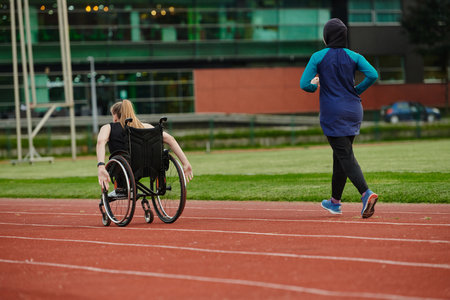Understanding Workplace Ergonomics
Workplace ergonomics is all about designing and arranging workspaces, tools, and tasks to fit the needs of employees. This is especially important for creating inclusive workplaces where everyone, including people with disabilities, can feel comfortable, productive, and supported. Good ergonomics helps reduce discomfort and injury while making sure everyone can do their job efficiently.
What Is Ergonomics?
Ergonomics means adapting the work environment to the person, not the other way around. It focuses on improving how people interact with their workspace so they can work safely and comfortably. For employees with disabilities, ergonomic solutions are often tailored to remove barriers and provide equal access to job opportunities.
Why Ergonomics Matters in Inclusive Workplaces
When employers pay attention to ergonomics, they help create a culture of inclusion and respect. This supports employees’ health and well-being, which can lead to better morale and higher productivity. For workers with disabilities, having an ergonomic workplace can mean the difference between struggling at work and thriving in their role.
Key Benefits of Ergonomics for All Employees
| Benefit | Description |
|---|---|
| Comfort | Reduces strain and fatigue by adapting equipment and furniture to individual needs. |
| Productivity | Makes tasks easier and more efficient for everyone, allowing employees to focus on their work. |
| Injury Prevention | Lowers the risk of repetitive stress injuries or discomfort from poor posture or unsuitable equipment. |
| Accessibility | Ensures that workspaces are usable by all employees, including those with mobility or sensory impairments. |
| Inclusivity | Promotes a welcoming environment where differences are respected and accommodated. |
Everyday Examples of Ergonomic Adjustments
- Adjustable desks and chairs to support different body types and abilities.
- Speech recognition software for employees with limited hand movement.
- Accessible pathways and ramps for wheelchair users.
- Larger monitors or screen readers for visually impaired staff.
- Task lighting options to help those with low vision or light sensitivity.
A focus on ergonomics ensures that every employee feels valued and empowered at work—no matter their physical abilities. By understanding these basics, employers can take steps toward creating truly inclusive workplaces.
2. Identifying Barriers and Opportunities
Recognizing Physical and Attitudinal Barriers
Creating an inclusive workplace for employees with disabilities starts by identifying what stands in their way. Barriers can be physical—like inaccessible workstations or tight hallways—or attitudinal, such as misconceptions about what people with disabilities can accomplish. Both types of barriers can limit opportunities and make employees feel excluded.
Common Workplace Barriers
| Type of Barrier | Examples |
|---|---|
| Physical | Narrow doorways, high desks, poorly placed equipment, lack of accessible restrooms |
| Attitudinal | Assuming someone needs help without asking, underestimating abilities, lack of disability awareness training |
Finding Opportunities for Inclusion
The good news is that every barrier presents a chance to make positive changes. Start by talking to employees—ask about their needs and listen openly. Collaborate to find solutions that work for everyone. Sometimes small adjustments, like rearranging furniture or providing adjustable chairs, make a big difference.
Practical Approaches to a More Inclusive Environment
| Approach | Description | Example in Practice |
|---|---|---|
| Flexible Workspaces | Create areas that adapt to different physical needs. | Height-adjustable desks and moveable monitors. |
| Inclusive Communication | Use clear language and offer information in multiple formats. | Email, print, audio recordings, or screen readers. |
| Cultural Sensitivity Training | Educate staff on disability etiquette and inclusion. | Workshops on respectful language and how to offer help appropriately. |
| Feedback Channels | Set up easy ways for employees to share concerns or ideas. | Anonymized suggestion boxes or regular check-in meetings. |
Tapping into Employee Expertise
Your team members with disabilities know best what supports their success. Invite them into the conversation when making decisions about ergonomics and workplace design. Their insights can help create a more welcoming environment for all.
![]()
3. Adapting Workspaces and Tools
Customizing Workstations for Every Employee
Creating an inclusive workplace means making sure everyone has the tools and setup they need to do their best work, including employees with disabilities. This process starts with customizing workstations based on each persons unique needs. Here are some ways companies can adapt workspaces:
| Workstation Element | Possible Adaptations |
|---|---|
| Desks | Height-adjustable desks, wheelchair-accessible designs, easy-to-reach controls |
| Chairs | Ergonomic seating, lumbar support, adjustable armrests, wider seats for mobility devices |
| Lighting | Task lighting, glare-free bulbs, voice-activated or touchless controls |
| Computer Setups | Monitor arms, screen magnifiers, anti-glare screens, alternative keyboards and mice |
| Storage & Organization | Shelving at accessible heights, pull-out drawers, labeled storage for easy access |
Selecting Adaptive Equipment
Adaptive equipment can help bridge the gap between standard office supplies and individual needs. Choosing the right adaptive tools is essential for meeting ADA guidelines and supporting productivity. Examples include:
- Speech recognition software: Allows employees to control computers using their voice.
- Braille displays and screen readers: Provide access for individuals who are blind or have low vision.
- One-handed keyboards or mouse alternatives: Help those with limited hand dexterity.
- Amplified phones and visual alert systems: Support employees who are deaf or hard of hearing.
- Sit-stand stools or footrests: Assist those with back or leg issues during long periods of sitting or standing.
Incorporating Technology to Meet Varying Needs
Technology plays a big role in making workplaces more inclusive. With the right tech solutions, employees with disabilities can perform tasks more easily and comfortably. Here are a few options that align with American standards like the ADA:
- Video conferencing tools with captioning: Ensure meetings are accessible to all participants.
- Accessibility features in office software: Text-to-speech, high contrast modes, and keyboard shortcuts help users with different abilities.
- Mobile apps for task management: Allow customization for reminders and checklists in ways that fit each persons preferences.
- Sensors and smart devices: Automate doors, lights, or climate controls to reduce physical barriers.
The Importance of Following ADA Guidelines
The Americans with Disabilities Act (ADA) sets clear expectations for accessibility in the workplace. Employers should always consider these standards when adapting spaces and choosing equipment. This not only ensures legal compliance but also builds a culture where every employee feels valued and empowered to succeed.
4. Policy, Training, and Support
Clear Policies for Inclusive Workplaces
Having clear workplace policies is the foundation of creating an inclusive environment for employees with disabilities. These policies help set expectations, outline available accommodations, and ensure everyone knows their rights and responsibilities. In the United States, the Americans with Disabilities Act (ADA) provides a legal framework, but companies need to go beyond just meeting the minimum requirements. Here are some key elements that every workplace policy should include:
| Policy Element | Why It Matters | Example |
|---|---|---|
| Accommodation Procedures | Makes it easy for employees to request what they need | Simple online forms or direct HR contact options |
| Confidentiality Guidelines | Protects employee privacy and builds trust | No unauthorized sharing of disability information |
| Anti-Discrimination Clauses | Ensures equal treatment for all employees | Zero tolerance for bias based on ability level |
| Accessible Reporting Channels | Allows concerns to be raised safely and efficiently | Anonymized hotlines or feedback emails |
Ongoing Ergonomics Training
Training shouldnt be a one-time event. Ongoing ergonomics training helps keep everyone updated on best practices and new tools that make workplaces more accessible. This benefits not only employees with disabilities but the entire team by reducing injuries and improving comfort. Key topics to cover in training sessions include:
- How to adjust workstations for different needs (height-adjustable desks, screen readers, special chairs)
- The importance of taking breaks and stretching to prevent strain injuries
- Recognizing early signs of discomfort or accessibility issues among colleagues
- Encouraging open communication about accommodation needs without stigma
Fostering a Culture of Support and Acceptance
A truly inclusive workplace does more than just provide resources—it fosters a culture where everyone feels valued and supported. Leaders can model inclusive behavior by:
- Celebrating diverse abilities during team meetings or company events
- Encouraging feedback from employees with disabilities about what works and what could improve
- Acknowledging when changes are made because of employee input, showing that voices are heard and respected
- Offering mentorship programs or support groups for employees with disabilities to connect and share experiences
The Role of Managers and HR Teams
Managers and HR play a critical role in supporting employees with disabilities. They should receive specialized training on:
- Identifying when someone might benefit from ergonomic adjustments or accommodations, even if not directly requested
- Navigating confidential conversations about health needs respectfully
- Promoting available resources and following up to ensure accommodations are effective
- Treating requests promptly so employees feel valued and supported
A Workplace Where Everyone Thrives Together
Cultivating strong policies, continuous training, and genuine support creates a workplace where all employees—including those with disabilities—can thrive together. By prioritizing inclusivity at every level, organizations send a powerful message: every individual matters, and everyone’s contributions are valued.
5. Collaborating for Continuous Improvement
Creating truly inclusive workplaces for employees with disabilities isn’t a one-time project—it’s an ongoing journey. To keep improving ergonomic support and accessibility, everyone in the organization should work together. Let’s look at how employees, occupational therapists, HR teams, and leadership can collaborate for continuous improvement.
Engaging Key Stakeholders
Every group in the workplace brings unique perspectives and skills to the table. Here’s how you can engage each group:
| Group | How They Contribute | Ways to Engage |
|---|---|---|
| Employees | Share firsthand experiences and identify barriers or needs. | Surveys, focus groups, open forums, anonymous feedback options. |
| Occupational Therapists | Assess workspaces and recommend ergonomic solutions tailored to individual needs. | Regular workspace evaluations, training sessions, 1:1 consultations. |
| HR Teams | Develop policies, manage accommodations, and track progress on inclusion goals. | Create clear accommodation processes, monitor policy effectiveness, provide resources. |
| Leadership | Set the tone for inclusivity and allocate resources to support ongoing improvements. | Communicate commitment to inclusion, budget for upgrades, support employee-led initiatives. |
Building a Feedback Loop
A continuous feedback loop helps organizations stay responsive to changing needs. Here are some simple steps:
- Collect Input Regularly: Use surveys or suggestion boxes so employees can share ideas any time.
- Assess Workspaces: Schedule regular check-ins with occupational therapists to review workstation setups.
- Review Policies: HR should periodically analyze accommodation requests and outcomes to spot trends or gaps.
- Act on Feedback: Leadership should prioritize changes based on feedback and update everyone on progress.
The Power of Teamwork
No one person or department can create an inclusive environment alone. By working together—listening to employees’ voices, using expert advice from occupational therapists, supporting HR processes, and having leadership champion these efforts—workplaces become better for everyone. Continuous collaboration ensures ergonomic practices adapt as needs evolve, making inclusion a lasting part of your company culture.


